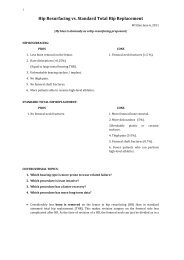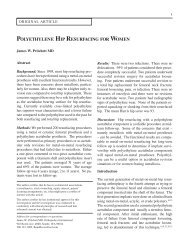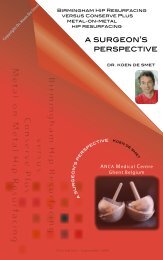Hip and Knee Arthroplasty - Surface Hippy Guide to Hip Resurfacing
Hip and Knee Arthroplasty - Surface Hippy Guide to Hip Resurfacing
Hip and Knee Arthroplasty - Surface Hippy Guide to Hip Resurfacing
You also want an ePaper? Increase the reach of your titles
YUMPU automatically turns print PDFs into web optimized ePapers that Google loves.
Effect of Age <strong>and</strong> Gender<br />
The risk of revision following primary<br />
unicompartmental knee replacement differs<br />
significantly by age, however there is no<br />
significant difference with respect <strong>to</strong> gender.<br />
The risk of revision significantly decreases with<br />
increasing age. The less than 55 year age group<br />
has the highest revision rate, 3.3 revisions per<br />
100 component years, <strong>and</strong> a seven year<br />
cumulative percent revision of 20.0%. In the<br />
remaining age groups 55-64, 65-74 <strong>and</strong> 75 years<br />
<strong>and</strong> older there is a gradual decline in the rate of<br />
revision per 100 observed component years (2.2,<br />
1.6 <strong>and</strong> 1.2 respectively) (Table KP16). The<br />
seven year cumulative percent revision also<br />
declines in a similar manner (14.5%, 9.5% <strong>and</strong><br />
6.1% respectively) (Table KP17 <strong>and</strong> Figure KP6).<br />
Although not significant, females have a higher<br />
revision rate compared <strong>to</strong> males (2.1 <strong>and</strong> 1.8<br />
revisions per 100 observed component years<br />
respectively), <strong>and</strong> a seven year cumulative<br />
percent revision of 12.9% <strong>and</strong> 11.0%<br />
respectively (Tables KP18 <strong>and</strong> KP19 <strong>and</strong> Figure<br />
KP7). The differences in risk of revision related<br />
<strong>to</strong> age previously mentioned are evident for both<br />
females <strong>and</strong> males (Tables KP20 <strong>and</strong> KP21 <strong>and</strong><br />
Figures KP8 <strong>and</strong> KP9).<br />
Prosthesis Specific Outcomes<br />
The revision per 100 observed component years<br />
<strong>and</strong> the seven year cumulative percent revision<br />
where available is provided for all<br />
unicompartmental prostheses (Tables KP22 <strong>and</strong><br />
KP23). There are 11 prostheses with over 1,000<br />
observed component years recorded by the<br />
Registry <strong>and</strong> of these the least revised are the<br />
M/G, Repicci <strong>and</strong> Freedom PKR/Active with 1.4<br />
revisions per 100 observed component years.<br />
The Freedom PKR/Active has a much shorter<br />
follow up period than the other two prostheses.<br />
The cumulative percent revision of these three<br />
prostheses is 8.1% at seven years for the M/G,<br />
6.9% at five years for the Repicci <strong>and</strong> 3.0% at<br />
two years for the Freedom PKR/Active. The ZUK,<br />
a relatively recent prosthesis, is already the<br />
second most used prosthesis in 2007 <strong>and</strong> has 0.9<br />
revisions per 100 observed component years <strong>and</strong><br />
a two year cumulative percent revision of 1.4%.<br />
(Adj HR=4.77; 95% CI (2.48, 9.18) p






